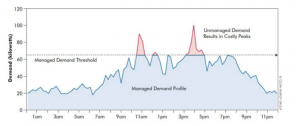How energy storage can improve solar economics for businesses and non-profits
Utility companies charge residential customers for how much energy they use. This is measured in kilowatt-hours (kWh) by the customer’s meter. Non-profit, commercial, and large industrial customers are charged for their energy usage as a well. And, they are charged for how much power they demand at their location. Power demand is measured in kilowatts (kW). These “demand charges” are also measured by the customer’s meter at regular intervals. The utility typically charges a rate based on the highest (or peak) demand for that customer during the month. These rates vary by utility and customer type.
Solar reduces energy costs (measured in kWh) but demand charges (measured in kW) are not always reduced by the addition of a solar array. Whether these charges are reduced depends on how close the solar array’s production matches up with the time of day when the customer needs the most power from the grid. Adding energy storage can save these customers even more money.
Energy vs. Power
The terms energy and power are often mixed together and used interchangeably when talking about electricity, but they are different. Energy is the measurement of (electrical) work being done over time. Power is the instantaneous measurement of how fast that work is happening. An analogy to this is a bathtub filling up with water. The amount of water in the bathtub is the energy. The rate the water is flowing into the tub is power. If the water comes out of the faucet quickly you are using more power than if the water comes out of the faucet more slowly. Either way, when the bathtub is completely full, you’ve used the same amount of energy.
Storage can generate savings
When a business or non-profit is being charged for demand the utility company is measuring at regular intervals how much power the customer is drawing from the grid. At the end of the month, whatever the peak power demand was becomes the basis for calculating the demand charge. If the maximum power demand in a month were 100 kilowatts (kW) and the demand charge were $10/kW than the demand charge would be $1,000 for that month.
When there’s an energy storage system on site, equipment connected to the storage releases stored energy at the right times to keep the equipment on the property from demanding more power from the utility grid. In the diagram below the red areas show where storage reduced demand during a day. Over a billing period this kind of activity “shaves” the peak demand a customer needs from the grid and reduces the demand charges.

Credit: Resilient Power Project (www.resilient-power.org)
In areas where demand charges are high, storage can make economic sense, reducing the peak need for power and saving the customer money. The non-profit Clean Energy Group in work done through their Resilient Power Project, estimates that broadly, demand charges of $10/kW or more can make adding storage a good idea.
Solar + Storage
Because commercial and non-profit customers are charged for energy usage ($/kWh) and power usage ($/kW) solar plus storage becomes a great combination. Solar reduces the amount the customer pays the utility for energy by generating kilowatt-hours (kWh) on site. Storage reduces the amount the customer pays the utility for power (kW) by reducing the instantaneous need for energy from the grid.
